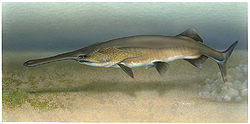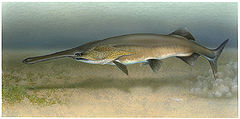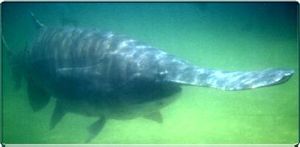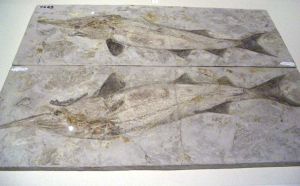Difference between revisions of "Paddlefish" - New World Encyclopedia
Rick Swarts (talk | contribs) |
Rick Swarts (talk | contribs) |
||
| Line 18: | Line 18: | ||
'''Paddlefish''' (family '''Polyodontidae''') are primitive [[Chondrostean]] [[ray-finned fish]]es. The paddlefish can be distinguished by its large [[mouth]] and its elongated, [[spatula]]-like [[snout]], called a [[rostrum (anatomy)|rostrum]], which is longer than the rest of the head. These fish are not closely related to [[shark]]s, which are in a different [[class (biology)|taxonomic class]], but they do have some body parts that resemble those of sharks such as their skeletons, primarily composed of [[cartilage]], and their deeply forked heterocercal [[Fish anatomy#Types of fin|tail fin]]s. This type of fish's age is hard to determine but many scientists{{Who|date=March 2009}} think that they live 50 years or more. | '''Paddlefish''' (family '''Polyodontidae''') are primitive [[Chondrostean]] [[ray-finned fish]]es. The paddlefish can be distinguished by its large [[mouth]] and its elongated, [[spatula]]-like [[snout]], called a [[rostrum (anatomy)|rostrum]], which is longer than the rest of the head. These fish are not closely related to [[shark]]s, which are in a different [[class (biology)|taxonomic class]], but they do have some body parts that resemble those of sharks such as their skeletons, primarily composed of [[cartilage]], and their deeply forked heterocercal [[Fish anatomy#Types of fin|tail fin]]s. This type of fish's age is hard to determine but many scientists{{Who|date=March 2009}} think that they live 50 years or more. | ||
| + | |||
| + | Froese, Rainer, and Daniel Pauly, eds. (2009). "Polyodontidae" in FishBase. January 2009 version. | ||
paddlelike snout; body lacking large scutes of acipenerids but small "scales" in sme regions; minute barbels on snout; long gill rakes; minute tteth; | paddlelike snout; body lacking large scutes of acipenerids but small "scales" in sme regions; minute barbels on snout; long gill rakes; minute tteth; | ||
Revision as of 01:39, 24 August 2012
| Paddlefishes
| ||||||||||
|---|---|---|---|---|---|---|---|---|---|---|
 American Paddlefish, Polyodon spathula
| ||||||||||
| Scientific classification | ||||||||||
| ||||||||||
|
Polyodon |
Paddlefish (family Polyodontidae) are primitive Chondrostean ray-finned fishes. The paddlefish can be distinguished by its large mouth and its elongated, spatula-like snout, called a rostrum, which is longer than the rest of the head. These fish are not closely related to sharks, which are in a different taxonomic class, but they do have some body parts that resemble those of sharks such as their skeletons, primarily composed of cartilage, and their deeply forked heterocercal tail fins. This type of fish's age is hard to determine but many scientists[attribution needed] think that they live 50 years or more.
Froese, Rainer, and Daniel Pauly, eds. (2009). "Polyodontidae" in FishBase. January 2009 version.
paddlelike snout; body lacking large scutes of acipenerids but small "scales" in sme regions; minute barbels on snout; long gill rakes; minute tteth;
- example: Sturgeon is the common name for any of the anadromous and freshwater fish comprising the family Acipenseridae of the Order Acipenseriformes of the Class Actinopterygii, characterized by an elongated body, largely cartilaginous skeleton, rows of bony scutes or plates on the body, four barbels in front of the mouth, and protrusible mouth.
There are only two modern species of these fish: the Chinese paddlefish (Psephurus gladius) and the American paddlefish (Polyodon spathula). Both have declined greatly in abundance, and the Chinese species may now be extinct. In some areas, paddlefish are referred to as "Spoonbill", "Spoonies" or "Spoonbill Catfish".
Overview and description
The Order Acipenseriformes includes two extant families: the sturgeons (family Acipenseridae) and the paddlefishes (family Polyodontidae). Members of this order are characterized by a largely cartilaginous structure, an elongated body, an intestine with spiral valve, a heterocercal caudal fin, the absence of gulars, lack of vertebral central, and fin rays more numerous than their basals (Nelson 2006).
The sturgeon family, Acipenseridae, is characterized by five rows of bony scutes or plates on the body, rather than scales; four barbels that precede the inferior and protrusible mouth; the absence of teeth in adults; a large swim bladder; fewer than 50 gill rakers; and pectoral fins with anterior spinous ray made up of fused rays (Nelson 2006). They also have a flattened rostra and elongated upper tail lobes. Collectively, the Acipenseridae family is also known as the true sturgeons. Members of the Acipenseridae differ from the paddlefish family Polyodontidae in that the latter have a paddlelike snout with minute barbels, the presence of minute teeth, and lack the large scutes of the acipenserids but have small "scales" in some regions; in some cases, paddlefish also have long gill rakers, including hundreds of gill rakers in the plankton-feeding Polyodon (Nelson 2006).
There are two currently or recently extant genera in this family and four (if not five) extinct genera:
- Genus Polyodon Lacépède, 1797
- Polyodon spathula Walbaum, 1792 American paddlefish
- Genus Psephurus Günther, 1873
- Psephurus gladius E. von Martens, 1862 Chinese paddlefish (Not recently verified extant, and perhaps now extinct)
- Genus Polyodon Lacépède, 1797
Early investigators[attribution needed] once thought that paddlefishes used their snouts to dig vegetation from the bottom of lakes and rivers. In fact, they feed by filtering out zooplankton from the water, using filaments on their gill arches called gill rakers, and in this respect appear similar to the basking shark.
As in many of the distantly related shark class, the paddlefish's rostrum contains electroreceptors that can detect weak electrical fields, suggesting that they use their rostrum as an antenna to detect zooplankton.[2] Even though the rostrum seems to help the fish feed, fish with severely damaged or missing rostrums are able to feed and appear to be just as healthy as other fish with them intact.
The rostrum also helps the fish to feed by acting as a stabilizer. As the fish moves through the water with its mouth open, the rostrum creates lift, much like a wing of an airplane. This helps the fish by keeping its head in a steady position and helps it keep from diving to the bottom.
Paddlefish lay their eggs in midstream over bare rocks or gravel. The eggs are adhesive and stick to the rocky substrate. The young are swept downstream after hatching and grow to adulthood in deep freshwater pools.[2]
American paddlefish
| American Paddlefish | ||||||||||||||
|---|---|---|---|---|---|---|---|---|---|---|---|---|---|---|
 | ||||||||||||||
| Scientific classification | ||||||||||||||
| ||||||||||||||
| Polyodon spathula (Walbaum in Artedi, 1792) |
The American paddlefish, Polyodon spathula, also called the Mississippi paddlefish or spoonbill, is a paddlefish living in slow-flowing waters of the Mississippi River drainage system. It appears to have been extirpated from Lake Erie and its tributaries. They are closely related to the sturgeons. This large Chondrostean freshwater fish may grow to 220 cm (7 feet) and weigh up to 100 kg (220 pounds). The paddlefish takes its common and scientific names from its distinctive snout, which is greatly elongated and flattened into a paddle shape. The American paddlefish is believed to use sensitive electroreceptors on its paddle to detect prey, as well as to navigate while migrating to spawning sites. The American paddlefish feeds primarily on zooplankton but also feeds on crustaceans and bivalves. Polyodon spathula is one of two living species of Paddlefish; the other is the possibly extinct Chinese Paddlefish, Psephurus gladius.
The American paddlefish (Polyodon spathula) is currently known from the Mississippi River watershed in the United States, including slow-flowing waters of the Mississippi River itself, as well as various tributaries including the Missouri River, Ohio River, Yellowstone River, Wisconsin River, Des Moines River, and Arkansas River systems. These fish were also found historically in Lake Erie, in the Great Lakes, but in May 2000, the Canadian Species at Risk Act listed the paddlefish as being extirpated in Canada.
The American paddlefish is one of the largest freshwater fish in North America. They commonly reach 5 feet (1.5 m) or more in length and can weigh more than 60 pounds (27 kg). The largest American paddlefish on record, weighing 144 pounds (65 kg), was caught by Clinton Boldridge in the Atchison Watershed in Kansas. The largest unofficial record was 206 pounds from Lake Cumberland in Kentucky;[citation needed] postcards from the 1960sTemplate:Which? show a photo of this huge fish.
Population decline
Though the American paddlefish was once common throughout the Midwest, overfishing and habitat changes have caused major population declines; both the meat and roe of Polyodon spathula are desirable as food. Dams and other barriers can prevent the fish from recolonizing places where they once occurred and can deny them access to important critical habitats such as spawning areas. Until about 1900, the species was also found in Lake Erie and in river systems tributary thereto in the U.S. and Canada. Invasive species such as zebra mussels have reduced the number of zooplankton in the Great Lakes to such low levels that any hypothetical reintroduction program would seem likely to fail. Recently, paddlefish were spotted in the Danube river. It has not been determined whether these fished escaped from Romanian or Bulgarian fish farms during the 2006 European floods, or whether they were let into the Danube earlier and matured in the river.
Sport fishing
The American paddlefish remains a popular sport fish in those parts of its range where populations are sufficient to allow harvesting. Since they are filter-feeders, paddlefish will not accept bait or lures and must be caught by snagging. Several states, including Missouri, have enacted stocking programs for these fish in reservoirs where the resident populations were low or nonexistent, or in areas where historical populations are no longer naturally sustainable. Paddlefish roe is occasionally sold as "American Sevruga Caviar"[1].
ReferencesISBN links support NWE through referral fees
- Grady 2004. [2]. 2006 IUCN Red List of Threatened Species., World Conservation Union. Retrieved on 11 May 2006. Database entry includes a lengthy justification of why this species is vulnerable
- Polyodon spathula (TSN {{{ID}}}). Integrated Taxonomic Information System.
- Template:FishBase species
- Barry Patrick M., Robert F. Carline, David G. Argent, William G. Kimmel. 2007. Movement and Habitat Use of Stocked Juvenile Paddlefish in the Ohio River System, Pennsylvania. North American Journal of Fisheries Management 27:1316-1325
- Bettoli Phillip W., George D. Scholten, William C. Reeves. 2007. Protecting Paddlefish from Overfishing: A Case History of the Research and Regulatory Process. Fisheries, American Fisheries Society 32:390-397
- Boone, E.A., and T.J. Timmons. 1994. Density and natural mortality of paddlefish,Polyodon spathula, in an unfished Cumberland River subimpoundment, South Cross Reservoir, TN. Journal of Freshwater Ecology 10: 421-431
- Cheblukov V. P., V. Ye. Kharin. 2009. The First Finding of the American Paddlefish "Polyodon Spathula" (Polyodontidae)in waters of the Russian Far East. Russian Journal of Marine Biology 35:611-613
- Miller S. E., D. L. Scarnecchia. 2008. Adult paddlefish migrations in relation to spring river conditions of the Yellowstone and Missouri rivers, Montana and North Dakota, USA. Journal of Applied Icthiology 24:221-228
- Onders Richard J., Steven D. Mims, Carl D. Webster, Ann L. Gannam. 2009. Apparent digestibility coefficients of protein, lipid and carbohydrate in practical diets fed to paddlefish, "polyodon spathula" (Walbaum). Wiley Interscience 40:1785-1788
- Pitman, V.M., and J.O. Parks. 1994. Habitat use and movement of young paddlefish, Polyodon spathula. Journal of Freshwater Ecology 33:181-190
- Rosen, R.A., and D.C. Hales. 1981. Feeding of paddlefish,Polyodon spathula. Copeia 2:441-455
- Russell, D.F., L.A. Wilkens, and F. Moss. 1999. Use of behavioural stochastic resonance by paddlefish for feeding. Nature 402:291-294
- Scholten, G.D., and P.W. Betoli. 2005. Population characteristics and assessment of overfishing for an exploited paddlefish population in the lower Tennessee River. Transactions of the American Fisheries Society 134:1285-1298
- Zigler, S.J., M.R. Dewey, B.C. Knights, A.L. Runstrom, and M.T. Steingraeber. 2004. Hydrologic and hydraulic factors affecting passage of paddlefish through dams in the upper Missouri River. Transactions of the American Fisheries Society 133:160-172
Chinese paddlefish
| Chinese Paddlefish | ||||||||||||||
|---|---|---|---|---|---|---|---|---|---|---|---|---|---|---|
| [[image:Psephurus gladius.jpg | ]] | |||||||||||||
| Scientific classification | ||||||||||||||
| ||||||||||||||
| Psephurus gladius (E. von Martens, 1862) | ||||||||||||||
|
Polyodon gladius |
Chinese Paddlefish, Psephurus gladius (simplified Chinese: 白鲟; traditional Chinese: 白鱘; Template:!(Template:!(pinyin]]: báixún), also known as Chinese Swordfish, are among the largest freshwater fish. It is one of two extant paddlefish species, the other being the American Paddlefish (Polyodon spathula). It is also called "elephant fish" (象魚; xiàngyú) because its snout resembles an elephant trunk. It is recorded sometimes in Classical Chinese as wěi-fish (鮪). More poetically, it is sometimes referred to as the "Giant Panda of the Rivers", not because of any physical resemblance to a panda, but because of its rarity and protected status.
- The Chinese paddlefish (Psephurus gladius) is (or was) known only from the Yangtze River in China. Nine-foot (3-meter) specimens weighing 300 kilograms (660 lb) have been recorded, and reports of 7 meters (23 ft) fish exist,[citation needed] although the existence of such large specimens is doubtful. They may now be extinct, with a recently completed three-year survey of the Yangtze finding no specimens.[3]
September 30, 2009, 10:24 am 47 Comments
For Chinese Paddlefish, a Long Goodbye By ANDREW C. REVKIN
"The Chinese paddlefish, a denizen of the Yangtze River, has not been seen alive for six years, despite thorough surveys."
The Chinese Paddlefish is the People's Republic of China's first-level protected animal. Its belly is white and back and head grey. They live mostly in the middle or lower part of the Yangtze (Chang Jiang), occasionally in large lakes. They feed on other fish, as well as small amounts of crabs and crayfish. Paddlefish are sexually mature at age seven or eight, with a typical body length of 2 metres and a weight of 25 kilograms.
It is said that the zoologist Bǐng Zhì (秉志) recorded around the 1950s that some fishermen caught a paddlefish of 7-metres, although the authenticity of the story is unconfirmed. It is said that the Chinese paddlefish can grow to 23 feet and weigh 1,100 pounds, but little research on a maximum size can be conducted today due to the species' scarcity.
Due to overfishing, the Chinese Paddlefish is critically endangered now, and officially recognized by the People's Republic in 1983 to prevent fishing of paddlefish young or adults. Paddlefish are also threatened by dams (such as the Three Gorges Dam) which divide the population into isolated groups. The fish are rarely seen, recently raising concerns that the species might already be extinct. During a three-year search conducted from 2006–2008 a research team from the Chinese Academy of Fisheries Science in Jingzhou failed to find even one specimen.[4] The last confirmed sighting of the fish alive occurred January 24, 2003 on the Yangtze.[4] However, a 3.6-meter, 250 kilogram specimen was captured by illegal fishing on January 8, 2007, in Jiayu County. Local villagers contacted officials who rushed to the site. Zeb Hogan of Monster Fish on National Geographic Channel and other conservationists transferred the fish to a holding pen in hope that it would survive. But shortly afterwards it died due to unrecoverable injuries sustained while thrashing in the net.[5]
References
- Template:FishBase species
- Sturgeon Specialist Group 1996. [3]. 2006 IUCN Red List of Threatened Species., World Conservation Union. Retrieved on 11 May 2006. Listed as Critically Endangered (CR A2cd v2.3)
- ↑ "Polyodontidae". FishBase. Ed. Ranier Froese and Daniel Pauly. January 2009 version. N.p.: FishBase, 2009.
- ↑ 2.0 2.1 Wiley, Edward G. (1998). in Paxton, J.R. & Eschmeyer, W.N.: Encyclopedia of Fishes. San Diego: Academic Press, 77–78. ISBN 0-12-547665-5.
- ↑ Revkin, Andrew C., "For Chinese Paddlefish, a Long Goodbye", The New York Times, 2009-09-30. Retrieved 2010-05-20.
- ↑ 4.0 4.1 Bourton, Jody, "Giant fish 'verges on extinction'", BBC, 2009-09-29. Retrieved 2009-09-29.
- ↑ "Chinese Paddlefish Dies in Illegal Fishing", China Radio International, 2007-01-12. Retrieved 2009-09-29.
Classification
There are two currently or recently extant genera in this family and four (if not five) extinct genera: Polyodontidae
- Subfamily †Paleopsephurinae
- Genus †Paleopsephurus MacAlpin, 1947
- Species †Paleopsephurus wilsoni MacAlpin, 1947
- Genus †Paleopsephurus MacAlpin, 1947
- Subfamily Polyodontinae
- Genus †Crossopholis Cope, 1883
- Species †Crossopholis magnicaudatus Cope, 1883
- Genus Polyodon Lacépède, 1797
- Polyodon spathula Walbaum, 1792 American paddlefish
- †Polyodon tuberculata Grande & Bemis, 1991
- Genus Psephurus Günther, 1873
- Psephurus gladius E. von Martens, 1862 Chinese paddlefish (Not recently verified extant, and perhaps now extinct)
- Genus †Crossopholis Cope, 1883
- Subfamily †Protopsephurinae Grande & Bemis, 1996
- Genus †Protopsephurus Lu, 1994
- Species †Protopsephurus liui Lu, 1994
- Genus †Protopsephurus Lu, 1994
Fossils of other kinds of paddlefish have been found. One such species is Crossopholis magnicaudatus, from the Eocene-age Green River Shale deposit in Wyoming.
Status
Paddlefish were at one time very abundant in most central U.S. river systems, but populations have declined greatly due to overharvesting, sedimentation, and river modification. One of the major reasons for declining paddlefish numbers are the dams constructed on many major U.S. river systems. Paddlefish avoid fish ladders because of the metal rebar used in construction, which disrupts their electro-magnetic sense organs. The dams block paddlefish migration routes that are very important to the fish for spawning.
One other reason for the decreased numbers of paddlefish is overfishing. Pennsylvania Fish and Boat Commissioners are reintroducing the species to historical habitats in the Ohio and Allegheny rivers in an effort to establish a secure breeding population once again. Reintroduction efforts may take many years, since paddlefish mature slowly, lengthening the time required to establish a breeding population. Oklahoma has drastically reduced sportfish harvest of paddlefish to one per person per day to help sustain populations. Paddlefish are a protected species in Wisconsin, where they occur in the Wisconsin River south of the Prairie du Sac hydroelectric dam and in the lower Saint Croix River in Pierce County.
Caviar harvest
During the last century, paddlefish and sturgeon have been commercially exploited for their eggs (roe), called caviar. Paddlefish and sturgeon are two of the most important fish for freshwater caviar. Paddlefish take many years before they are able to spawn. A female may take nine to ten years, when they are about 42 inches long, and males seven-years-old and 40 inches long are able to spawn. The female releases adhesive eggs randomly over the water bottom and abandons them. They are capable of producing over a half million eggs a year, but they may not spawn every year.
The Oklahoma Fish and Game Department set up Paddlefish Survey stations in various highly fished areas in the state. The Fish and Game biologists record length and weight measurements, and cut a portion of the lower jaw to determine age. To encourage participation in past surveys the Fish and Game Department has offered fish cleaning and preparation services, returning the cleaned fish in heat-sealed packaging, and has offered key tag souvenirs. The Fish and Game department keeps the eggs (roe) for licensed resale, with the proceeds keep the study funded without expense to the public.
The Glendive Chamber of Commerce & Agriculture in Glendive, Montana sells Yellowstone Caviar. This caviar is harvested Paddlefish caviar that is processed from fish caught at Intake Fishing Area. The Intake Fishing Area is a fishing access site about eighteen miles north of Glendive in Eastern Montana. This caviar has been harvested since 1989 with 70% of the proceeds going to the Glendive Chamber of Commerce & Agriculture and 30% going to the Montana Department of Fish, Wildlife and Parks.
Current threats
Paddlefish are targeted by poachers for their valuable eggs, and are protected by law over a large part of their range. Habitat destruction is also causing their numbers to decrease more rapidly. Paddlefish need free-flowing rivers that have shallow pools with sandy, rocky bottoms for their spawning. Water temperature is also important for spawning. Modification of rivers by the construction of dams, dredging, and water removal for agricultural use reduces paddlefish spawning grounds.
Free-flowing lakes with reservoirs can also provide paddlefish breeding habitat. One such area is the Missouri River-Lake Sakakawea system in North Dakota. This area is capable of producing good paddlefish numbers because it is a free-flowing system with many good areas for paddlefish to spawn.
Fishing for paddlefish
Template:Ref improve section In most of its range the paddlefish is a protected species, and fishing for paddlefish is illegal in many areas. Any paddlefish caught accidentally should be released unharmed as quickly as possible. However, a few states still allow sport fishing for paddlefish.[1] Because paddlefish are filter feeders, they do not take conventional lures. Taking paddlefish is done with a bow and arrow, a spear, or by snagging (deliberately foul-hooking the fish in the fins or tail). Snagging is the usual method.
Poachers also use these methods to target paddlefish in areas where paddlefish fishing is not legal. Suspect paddlefish fishing activity can be reported to fish and wildlife officers who will verify legality. Some jurisdictions pay a financial reward to citizens whose report leads to prosecution of a poacher. One example is the Iowa DNR, and their Turn In Poachers (TIP) Program which was started in August 1985. The private TIP organization was established by concerned sportsmen and women under the guidance of the Iowa Department of Natural Resources Law Enforcement Bureau. Both groups recognized the need for an added dimension to fish and game law enforcement in the State of Iowa to aid in the fight against poaching.[2]
References
- Nelson, J. S. 2006. Fishes of the World, 4th edition. Hoboken, NJ: John Wiley & Sons. ISBN 0471250317.
External links
- The Chinese Paddlefish Website - containing many photographs of Psepherus.
- ARKive - images and movies of the paddlefish (Polyodon spathula)
- FishBase entry for Polyodontidae
- USGS UMESC Paddlefish Study
- Sites.state.pa.us
- Fisheries.org
- DNR.state.oh.us
- Stochastic synchronization of electroreceptors in the paddlefish
Template:Acipenseriformes
Credits
New World Encyclopedia writers and editors rewrote and completed the Wikipedia article in accordance with New World Encyclopedia standards. This article abides by terms of the Creative Commons CC-by-sa 3.0 License (CC-by-sa), which may be used and disseminated with proper attribution. Credit is due under the terms of this license that can reference both the New World Encyclopedia contributors and the selfless volunteer contributors of the Wikimedia Foundation. To cite this article click here for a list of acceptable citing formats.The history of earlier contributions by wikipedians is accessible to researchers here:
The history of this article since it was imported to New World Encyclopedia:
Note: Some restrictions may apply to use of individual images which are separately licensed.



